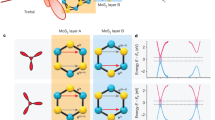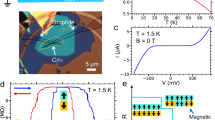Abstract
Current-induced magnetization switching driven by spin–orbit torques on sub-nanosecond timescales could be used to create fast and low-power spintronic devices. The time-resolved detection and analysis of switching trajectories in ferromagnet/antiferromagnet exchange-biased structures are the key to designing spin–orbit torque devices with high speed, but insight remains limited. Here we report the time-resolved detection of spin–orbit torque switching of the magnetization and exchange bias in platinum/cobalt/iridium–manganese heterostructures. Using time-resolved magneto-optical Kerr microscopy, combined with micromagnetic simulations, we show that the ferromagnets, as well as interfacial antiferromagnetic spins and exchange bias, can be partially switched by sub-nanosecond current pulses, which allows the switching probabilities to be flexibly controlled at multiple levels. We also show that the spin–orbit-torque-induced switching of the exchange bias, which intimately depends on the current density, can stabilize multilevelled magnetization switching within sub-nanosecond current pulses.
This is a preview of subscription content, access via your institution
Access options
Access Nature and 54 other Nature Portfolio journals
Get Nature+, our best-value online-access subscription
$29.99 / 30 days
cancel any time
Subscribe to this journal
Receive 12 digital issues and online access to articles
$119.00 per year
only $9.92 per issue
Buy this article
- Purchase on Springer Link
- Instant access to full article PDF
Prices may be subject to local taxes which are calculated during checkout





Similar content being viewed by others
Data availability
The data that support the findings of this study are available from the corresponding authors upon reasonable request.
References
Manchon, A. et al. Current-induced spin-orbit torques in ferromagnetic and antiferromagnetic systems. Rev. Mod. Phys. 91, 035004 (2019).
Jhuria, K. et al. Spin–orbit torque switching of a ferromagnet with picosecond electrical pulses. Nat. Electron. 3, 680–686 (2020).
Song, C. et al. Spin-orbit torques: materials, mechanisms, performances, and potential applications. Prog. Mater. Sci. 118, 100761 (2021).
Miron, I. M. et al. Perpendicular switching of a single ferromagnetic layer induced by in-plane current injection. Nature 476, 189–193 (2011).
Liu, L., Lee, O. J., Gudmundsen, T. J., Ralph, D. C. & Buhrman, R. A. Current-induced switching of perpendicularly magnetized magnetic layers using spin torque from the spin Hall effect. Phys. Rev. Lett. 109, 096602 (2012).
Fukami, S., Zhang, C., DuttaGupta, S., Kurenkov, A. & Ohno, H. Magnetization switching by spin–orbit torque in an antiferromagnet–ferromagnet bilayer system. Nat. Mater. 15, 535–541 (2016).
Lau, Y., Betto, D., Rode, K., Coey, J. M. D. & Stamenov, P. Spin–orbit torque switching without an external field using interlayer exchange coupling. Nat. Nanotechnol. 11, 758–762 (2016).
Oh, Y. et al. Field-free switching of perpendicular magnetization through spin–orbit torque in antiferromagnet/ferromagnet/oxide structures. Nat. Nanotechnol. 11, 878–884 (2016).
van der Brink, A. et al. Field-free magnetization reversal by spin-Hall effect and exchange bias. Nat. Commun. 7, 10854 (2016).
Lin, P. et al. Manipulating exchange bias by spin–orbit torque. Nat. Mater. 18, 335–341 (2019).
Peng, S. et al. Exchange bias switching in an antiferromagnet/ferromagnet bilayer driven by spin–orbit torque. Nat. Electron. 3, 757–764 (2020).
Zhang, E. Z. et al. Manipulating antiferromagnetic interfacial states by spin-orbit torques. Phys. Rev. B 104, 134408 (2021).
Baltz, V. et al. Antiferromagnet spintronics. Rev. Mod. Phys. 90, 015005 (2018).
Gurung, G., Shao, D. & Tsymbal, E. Y. Spin-torque switching of noncollinear antiferromagnetic antiperovskites. Phys. Rev. B 101, 140405 (2020).
Kurenkov, A. et al. Artificial neuron and synapse realized in an antiferromagnet/ferromagnet heterostructure using dynamics of spin–orbit torque switching. Adv. Mater. 31, 1900636 (2019).
Kašpar, Z. et al. Quenching of an antiferromagnet into high resistivity states using electrical or ultrashort optical pulses. Nat. Electron. 4, 30–37 (2021).
Krishnaswamy, G. et al. Multidomain memristive switching of Pt38Mn62/[Co/Ni]n multilayers. Phys. Rev. Appl. 14, 044036 (2020).
Decker, M. M. et al. Time resolved measurements of the switching trajectory of Pt/Co elements induced by spin-orbit torques. Phys. Rev. Lett. 118, 257201 (2017).
Cai, K. et al. Ultrafast and energy-efficient spin–orbit torque switching in compensated ferrimagnets. Nat. Electron. 3, 37–42 (2020).
Baumgartner, M. et al. Spatially and time-resolved magnetization dynamics driven by spin–orbit torques. Nat. Nanotechnol. 12, 980–986 (2017).
Legrand, W., Ramaswamy, R., Mishra, R. & Yang, H. Coherent subnanosecond switching of perpendicular magnetization by the fieldlike spin-orbit torque without an external magnetic field. Phys. Rev. Appl. 3, 064012 (2015).
Grimaldi, E. et al. Single-shot dynamics of spin-orbit torque and spin transfer torque switching in three-terminal magnetic tunnel junctions. Nat. Nanotechnol. 15, 111–117 (2020).
Kurenkov, A., Fukami, S. & Ohno, H. Neuromorphic computing with antiferromagnetic spintronics. J. Appl. Phys. 128, 010902 (2020).
Zhang, W., Jungfleisch, M. B., Jiang, W., Pearson, J. E. & Hoffmann, A. Spin Hall effects in metallic antiferromagnets. Phys. Rev. Lett. 113, 196602 (2014).
Frangou, L. et al. Enhanced spin pumping efficiency in antiferromagnetic IrMn thin films around the magnetic phase transition. Phys. Rev. Lett. 116, 077203 (2016).
Garello, K. et al. Ultrafast magnetization switching by spin-orbit torques. Appl. Phys. Lett. 105, 212402 (2014).
Lee, K. S., Lee, S. W., Min, B. C. & Lee, K. J. Thermally activated switching of perpendicular magnet by spin-orbit spin torque. Appl. Phys. Lett. 104, 072413 (2014).
Yoon, J. et al. Anomalous spin-orbit torque switching due to field-like torque–assisted domain wall reflection. Sci. Adv. 3, 1603099 (2017).
Fitzsimmons, M. R. et al. Antiferromagnetic domain size and exchange bias. Phys. Rev. B 77, 224406 (2008).
Nogués, J. & Schuller, I. K. Exchange bias. J. Magn. Magn. Mater. 198, 203–232 (1999).
Kaeswurm, B. & O’Grady, K. The origin of athermal training in polycrystalline metallic exchange bias thin films. Appl. Phys. Lett. 99, 222508 (2011).
Vallobra, P. et al. Manipulating exchange bias using all-optical helicity-dependent switching. Phys. Rev. B 96, 144403 (2017).
O’Grady, K., Fernandez-Outon, L. E. & Vallejo-Fernandez, G. A new paradigm for exchange bias in polycrystalline thin films. J. Magn. Magn. Mater. 322, 883–899 (2010).
Elphick, K., O’Grady, K. & Vallejo-Fernandez, G. Perpendicular exchange bias in (Co/Pt)n multilayers. IEEE Trans. Magn. 55, 4800106 (2019).
Zhou, J. et al. Magnetic asymmetry induced anomalous spin-orbit torque in IrMn. Phys. Rev. B 101, 184403 (2020).
Vallejo-Fernandez, G., Aley, N. P., Chapman, J. N. & O’Grady, K. Measurement of the attempt frequency in antiferromagnets. Appl. Phys. Lett. 97, 222505 (2010).
Vansteenkiste, A. et al. The design and verification of MuMax3. AIP Adv. 4, 107133 (2014).
Clercq, J. D., Vansteenkiste, A., Abes, M., Temst, K. & Waeyenberge, B. V. Modelling exchange bias with MuMax3. J. Phys. D: Appl. Phys. 49, 435001 (2016).
Clercq, J. D., Leliaert, J. & Waeyenberge, B. V. Modelling compensated antiferromagnetic interfaces with MuMax3. J. Phys. D: Appl. Phys. 50, 425002 (2017).
Garello, K. et al. Symmetry and magnitude of spin–orbit torques in ferromagnetic heterostructures. Nat. Nanotechnol. 8, 587–593 (2013).
Acknowledgements
Y.W. is grateful for the support from the Alexander von Humboldt Foundation. This work was financially supported by the National Natural Science Foundation of China (grant no. 62174095), German Science Foundation (DFG) via SFB 1277 and the Natural Science Foundation of Beijing Municipality (grant no. JQ20010). This work was partially supported by the Advanced Embedded Memory with 3 Dimensional Integrated Circuits (MOST110-2218-E-492-004-MBK) from Angstrom Semiconductor Initiative of Taiwan Semiconductor Research Institute, Ministry of Science and Technology, Taiwan.
Author information
Authors and Affiliations
Contributions
C.H.B. and Y.W. planned the study. Y.W. fabricated the devices and collected and analysed the data. T.T. and D.Z. carried out the micromagnetic calculations. P.-H.L. and C.-H.L. grew the samples and performed the magnetization measurements. Y.W., A.N. and J.S. carried out the MOKE measurements. Y.W. wrote the manuscript with input from T.T., C.H.B., C.S., H.W. and Q.D. All the authors discussed the results.
Corresponding authors
Ethics declarations
Competing interests
The authors declare no competing interests.
Peer review
Peer review information
Nature Electronics thanks Robert Carpenter and the other, anonymous, reviewer(s) for their contribution to the peer review of this work.
Additional information
Publisher’s note Springer Nature remains neutral with regard to jurisdictional claims in published maps and institutional affiliations.
Supplementary information
Supplementary Information
Supplementary Notes 1–7, Figs. 1–18 and discussion.
Rights and permissions
Springer Nature or its licensor (e.g. a society or other partner) holds exclusive rights to this article under a publishing agreement with the author(s) or other rightsholder(s); author self-archiving of the accepted manuscript version of this article is solely governed by the terms of such publishing agreement and applicable law.
About this article
Cite this article
Wang, Y., Taniguchi, T., Lin, PH. et al. Time-resolved detection of spin–orbit torque switching of magnetization and exchange bias. Nat Electron 5, 840–848 (2022). https://doi.org/10.1038/s41928-022-00870-3
Received:
Accepted:
Published:
Issue Date:
DOI: https://doi.org/10.1038/s41928-022-00870-3



